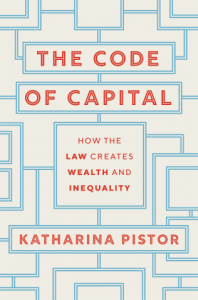In The Code of Capital: How the Law Creates Wealth and Inequality, Katharina Pistor offers an expansive analysis of the construction of capital, showing legal coding to be at the heart of this process. This is a welcome interdisciplinary contribution which attaches fresh dimensions to debates on the political economy of wealth and inequality and will be a valuable resource for anyone seeking to grapple with the formidable nature of global capital, writes Juvaria Jafri.
The Code of Capital: How the Law Creates Wealth and Inequality. Katharina Pistor. Princeton University Press. 2019.
Katharina Pistor’s The Code of Capital: How the Law Creates Wealth and Inequality is impressive and expansive. In essence, this book is a probe into the construction of capital. This process—of construction—involves two ingredients: an asset and the legal code. It is legal coding that turns an asset into capital and gives it the capacity to generate wealth for its owner.
This book may be read quickly or slowly. The hurried reader will appreciate the structure of the book, which makes its salient features easily accessible. Organised as nine chapters, the book begins by drawing linkages between present-day patterns of wealth inequality and market-centric policy shifts in the 1980s. These economic and legal reforms coincided with the demise of the Iron Curtain and socialist governments, and were implemented in developing as well as emerging markets, and promised eventual benefits for everyone. But instead, contemporary levels of inequality are comparable to those that prevailed before the French Revolution. A standard response to such disparity is simply to hold ‘capitalism’ accountable. But Pistor argues that even to do just this, it is necessary to be cognisant of how capital is made. To do so is to resist simplifications in which capital is a thing, or a core feature of social relations between a proletariat and a bourgeoisie: ‘Against this background, one might even question whether it makes sense to bundle historical epochs that differ so fundamentally from one another under a single rubric of “capitalism”’(10).
Pistor is wary of making claims to novelty in her observations that capital is the product of a process. In the past, Karl Marx described commodification as the process which makes objects tradeable and capable of generating profits. And Karl Polanyi distinguished classical factors of production—land, labour, capital—from commodities because only the latter are produced specifically for the market. But as Pistor notes, legal coding has enabled contemporary freelancers to ‘capitalise’ their labour, as is the case when self-employed persons establish a corporate entity and issue dividends to themselves as a corporation shareholder, instead of a salary. Under such an arrangement, the notion that capital and labour must be combined to produce goods is jettisoned. A key point, this calls for attention to the law as playing a crucial role in the coding of capital:
More generally, economists and accountants have clung to the notion that capital is a physical input, one of the two factors of production, when in fact capital has never been about a thing, but always about its legal coding; never just about output and input, but always about the ability to monetize expected returns (116).
Several instances of how intangibles are measured and valued are presented throughout the book to illustrate this point. Tangibles such as land, factories and machines have been overtaken by intangibles such as patents, copyrights and trademarks, in terms of how much they contribute to economic growth, particularly in the United States and the United Kingdom. Specific examples make the text consistently engaging. Hollywood celebrity Angelina Jolie’s experience—and subsequent op-ed, My Medical Choice—alluded to the legal battles waged by genetic testing company, Myriad Genetics, to charge a $3,000 fee for the BRCA test, which determined that the actor carried the breast cancer susceptibility gene type 1. This process of private enclosure was sanctioned by the US Supreme Court, even though the breakthrough that identified the genetic origins of breast cancer was the outcome of a major collaboration: the International Breast Cancer Linkage Consortium in which hundreds of government grant-supported researchers had participated.
Furthermore, the growth of the global derivatives market—which is at the core of financial instability and systemic collapses—would not have been possible were it not for the International Swaps and Derivatives Association (ISDA). Born in New York in 1985 and operating across international financial centres, including London and Tokyo, the ISDA is the most influential private organisation which codes law for global finance. By advancing standardisation in contracts, the ISDA has enabled hundreds of trillions in derivatives to be traded over the counter across dozens of countries. And though bankruptcy claims typically allow the debtor’s home laws to shape enforcement actions by creditors, the ISDA lobbying success resulted in more than 50 legislatures changing their laws so that state law would be consistent with private contracts.
Similar discussions which exemplify the expansionary imperative of global capital—which has been spurred by legal coding to create financial assets—are perhaps, owing to the level of detail, best suited for the more specialist reader. Such sections also contain rich sets of examples and are thematically joined by the chapters they reside in: these thus offer a pathway for anyone wishing to focus more sharply and engage deeply with what capital is, and the practical, day-to-day, implications of its nature. A range of spaces, including physical, intellectual and digital, are potential subjects for such an interrogation.
An intriguing departure from such discussions is found in Chapter Seven, ‘The Masters of the Code’. Here, Pistor appears to shift gears and delve into the institutional origins of legal coding. This entails reviewing how lawyers came to gain the influence they have in contemporary capitalism where ‘global capital exists and thrives without a global state or a global law’ (167). This is the result of the portability of law and has much to do with the dominance of common law systems over civil law systems. In this context, the most relevant common law systems are those of England and New York State; the most relevant civil law systems are those of Germany and France. Common law, relative to civil law, lets private lawyers constantly establish new legal rights. And because the only impediment they face is from a judge, who was also once a lawyer, they are more likely to have their way. While civil lawyers in Continental Europe might have become more like common lawyers in recent decades, they continue to be comparatively limited in their autonomy because of sharp lines between public and private offices: aspiring legal professionals receive specific training depending on whether they wish to become judges, prosecutors or private attorneys.
Overall, The Code of Capital is a welcome interdisciplinary contribution which attaches fresh dimensions to debates on the political economy of wealth and inequality. Aside from concluding with suggestions on how the power of legal coding can be arrested, it gives access to many aspects of global capital which were previously opaque to those who are not legal scholars. As such, it is a valuable resource for anyone seeking to grapple with the formidable nature of global capital.
Note: This review gives the views of the author, and not the position of the LSE Review of Books blog, or of the London School of Economics.
Image Credit: Image by 3D Animation Production Company from Pixabay.


 Find this book:
Find this book: 






4 Comments